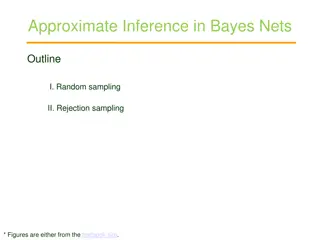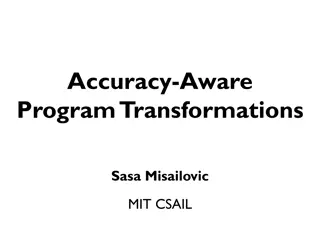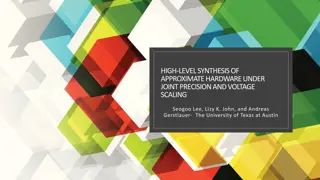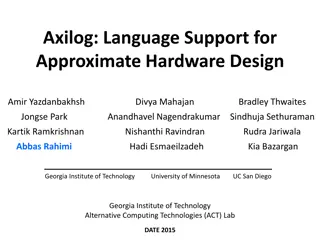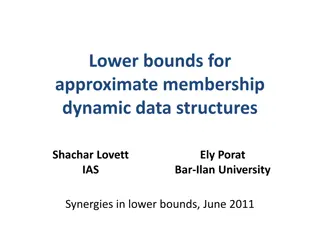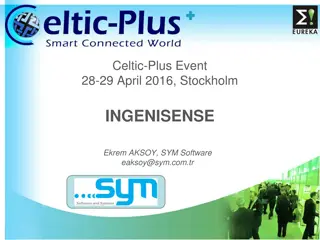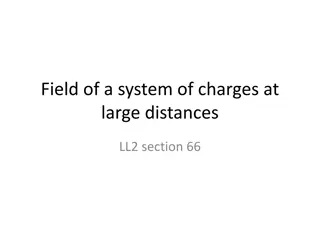
Efficient Hardware Implementation of Artificial Neural Networks Using Approximate Multiply-Accumulate Blocks
Gain insights into the efficient hardware implementation of artificial neural networks through the utilization of approximate multiply-accumulate blocks. Explore the application of ANNs in diverse design platforms and the significance of exploiting approximate computing for enhanced area, power, and energy efficiency.
Uploaded on | 1 Views
Download Presentation

Please find below an Image/Link to download the presentation.
The content on the website is provided AS IS for your information and personal use only. It may not be sold, licensed, or shared on other websites without obtaining consent from the author. If you encounter any issues during the download, it is possible that the publisher has removed the file from their server.
You are allowed to download the files provided on this website for personal or commercial use, subject to the condition that they are used lawfully. All files are the property of their respective owners.
The content on the website is provided AS IS for your information and personal use only. It may not be sold, licensed, or shared on other websites without obtaining consent from the author.
E N D
Presentation Transcript
Efficient Hardware Implementation of Artificial Efficient Hardware Implementation of Artificial Neural Networks Using Approximate Neural Networks Using Approximate Multiply Multiply- -Accumulate Blocks Accumulate Blocks Mohammadreza Esmali Nojehdeh, Levent Aksoy and Mustafa Altun Emerging Circuits and Computation (ECC) Group Istanbul Technical University IEEE Computer Society Annual Symposium on VLSI 2020
Outline Introduction Background Motivation ANN Design by Exploiting Approximate blocks Experimental Results Conclusions
Introduction Artificial neural network (ANN) is a computing system made up of a number of simple and highly interconnected processing elements ANNs have been applied to a wide range of problems classification and pattern recognition They have been realized in different design platforms analog, digital, hybrid very large scale integrated (VLSI) circuits, field programmable gate-arrays (FPGAs), and neuro-computers
Background Neuron - a fundamental unit of ANN An ANN architecture ? ? = (? + ?) ? = ???? Hidden Layers Input Layer Output Layer ?=1 Bias Activation Function ( ) b Weights Inputs x1 w1 w2 z1 x1 x2 y x2 wixi + z z2 xn x3 wn Hardware complexity of an ANN is dominated by the multiplication of weights by input variables.
Background Approximate computing is used for area, power, and energy improvement, targeting applications not strictly requiring high accuracy including image processing and learning. Conventional mirror adder cell transistor level schematic[1] Truth table for conventional full adder and approximate adder[1] Inputs B Accurate Sum Approximate Sum A Cin Cout Cout Layout Area of mirror adders[1] 0 0 0 0 0 0 0 Area( m2) 1 0 0 0 Mirror Adder Cell 0 0 1 1 0 1 0 0 1 0 Conventional 40.66 0 1 1 0 0 1 1 Approximate mirror adder cell transistor level schematic[1] Approximate 13.54 1 0 0 1 1 0 0 0 1 0 1 1 0 1 0 1 1 1 1 1 0 1 1 1 1 1 1 1 [1]Almurib, H.A.F., Kumar, T.N., Lombardi, F., 2016. Inexact designs for approximate low power addition by cell replacement, in: 2016 Design, Automation Test in Europe Conference Exhibition .
Motivation Time-multiplexed design of a neuron Control logic an up-counter Complexity number of inputs (or weights) Multiplexers Complexity number and bitwidths of inputs and weights Multiplier Complexity maximum bitwidths of inputs and weights Adder and register (R) Complexity bit-width of the inner product of inputs and weights ? ???? w1w2 wn MAC Control Logic b x1 x2 y + x + z R xn Simplified time-multiplexed design of a neuron c1c2 cn ? ??= ??/2? ? = ( ?=1 ????) << k MAC Control Logic b x1 x2 y + x + z R ? = <<k xn ?=1
Motivation Multipliers and adders arefrequently used in ANNs and dominate the hardware complexity. Since exploiting approximate multipliers and adders for neuron computation can be significantly reduces hardware complexity, taking into account the deviation in ANN accuracy. w1w2 wn MAC Control Logic b x1 x2 y + x X + + z R xn
Time-Multiplexed ANN Design The design procedure has three main steps: 1) Given the ANN structure, train the ANN using state-of-art techniques and find the weight and bias values 2) Post-training stage a) Determine the minimum quantization value b) Convert the floating-point weight and bias values to integers c) Replace multipliers and adders by approximate version and check accuracy 3) Describe the time-multiplexed ANN design in hardware
Training Our training tool includes several iterative optimization algorithms, namely conventional and stochastic gradient descent methods and Adam optimizer [2] different weight initialization techniques, namely Xavier [3], He [4], and fully random several stopping criteria, namely number of iterations, early stopping using validation data set, and saturation of logic functions different activation functions for neurons in each layer, namely sigmoid, hyperbolic tangent, hard sigmoid, hard hyperbolic tangent, linear rectified linear unit, and softmax [2] D. P. Kingma and J. Ba, Adam: A method for stochastic optimization, arXiv e-prints, 2014, arXiv:1412.6980. [3] X. Glorot and Y. Bengio, Understanding the difficulty of training deep feedforward neural networks, in International Conference on Artificial Intelligence and Statistics, 2010, pp. 249 256. [4] K. He, X. Zhang, S. Ren, and J. Sun, Delving deep into rectifiers: Surpassing human-level performance on imagenet classification, arXiv e-prints, 2015, arXiv:1502.01852.
Hardware-aware Post-training Computing the minimum quantization value 1) Set the quantization value, q, and the related ANN accuracy in hardware, ha(q), to 0 2) Increase q by 1 3) Convert each floating-point weight and bias value to an integer by multiplying it 2qand ceiling this multiplication result 4) Compute ha(q) value on the validation data set using the integer weight values 5) If ha(q) > 0 and ha(q) ha(q-1) > 0.1%, go to Step 2 6) Otherwise, return q as the minimum quantization value
Hardware Design ANN Design Using a MAC Block for each Neuron (SMAC NEURON) ANN Design Using a Single MAC Block (SMAC ANN)
Hardware Design Approximate multiplier is implemented by setting rleast significant output of an exact multiplier to zero, where r denotes its approximation level. Approximate 4-bit Unsigned Multiplier with Lest 3 bits are set to logic value 0 Exact 4-bit Unsigned Multiplier 0 0 0
Experimental Results Pen-based handwritten digit recognition problem [24] was used as an application. In the convolutional neural network design of this application, 5 ANN structures with different number of hidden layers and number of neurons in the hidden layers were used. ANN structure is 16-16-10 and was implemented in two different architectures Time-multiplexed using a MAC block for each neuron Time-multiplexed using a single MAC block for ANN ANN designs were described in Verilog and synthesized using the Cadence RTL Compiler with the TSMC 40nm design library.
Experimental Results RESULTS OF SMAC NEURON ARCHITECTURE USING APPROXIMATE MULTIPLIERS. Approximate level Multiplier Type area ( m2) delay (ns) latency (ns) power (mW) energy (pj) HMR area gain energy gain Hidden Output Behavioral 0 0 3.58 121.68 1.44 174.77 5.00 0% 0% 15327 mul12s_2NM[5] NA 3.72 5.12 9% 11% 13929 NA 126.31 1.23 155.04 Mul_12s_2KM[5] NA NA 5.00 -12% -3% 17227 3.70 125.80 1.44 181.33 PBAM[6] 7 11 13% 9% 13276 3.57 121.35 1.31 159.14 4.85 PBAM[6] 7 12 5.03 7% 15% 12,992 3.66 124.37 1.30 161.52 PBAM[6] 8 11 5.37 17% 17% 12761 3.41 115.91 1.26 145.51 LEBZAM 9 5.03 28% 22% 6 11999 3.68 125.02 1.00 125.21 LEBZAM 7 11 4.80 30% 33% 10224 3.45 117.40 1.04 122.05 LEBZAM 7 12 37% 36% 9723 3.41 116.01 0.94 109.41 5.09 [5] V. Mrazek, R. Hrbacek, Z. Vasicek, and L. Sekanina, Evoapproxsb:Library of approximate adders and multipliers for circuit design and benchmarking of approximation methods, in Design, Automation and Test in Europe Conference and Exhibition (DATE), 2017, pp. 258 261. [6] M. E. Nojehdeh and M. Altun, Systematic synthesis of approximate adders and multipliers with accurate error calculations, Integration, vol. 70, pp. 99 107, 2020.
Experimental Results RESULTS OF SMAC NEURON ARCHITECTURE USING APPROXIMATE MULTIPLIERS AND ADDERS. Approximate level Multiplier Type area ( m2) delay (ns) latency (ns) power (mW) energy (pj) HMR area gain energy gain Hidden Output Mul Add Mul Add 0 0 0 0 15327 3.58 121.68 1.44 174.77 5.00 0% 0% Behavioral mul12s_2NM[5] NA 14 55% NA 10 11854 3.92 133.14 0.59 78.76 5.17 23% NA 9 NA 15 47% 13133 3.95 134.30 0.69 92.48 5.35 14% Mul_12s_2KM[5] 7 7 12 11 21% 56% 10226 3.66 124.37 0.61 76.25 5.03 PBAM[6] 7 7 12 12 37% 57% 9798 3.64 123.86 0.61 75.70 5.20 PBAM[6] 7 7 12 13 39% 56% 9354 3.66 124.37 0.62 77.25 5.17 PBAM[6] 9 13 32% 60% 6 10 10392 3.58 121.72 0.58 70.11 5.32 LEBZAM 7 12 10 13 43% 61% 8801 3.61 122.88 0.55 67.32 4.89 LEBZAM 7 11 10 14 63% 41% 8989 3.61 122.81 0.52 63.68 4.97 LEBZAM [5] V. Mrazek, R. Hrbacek, Z. Vasicek, and L. Sekanina, Evoapproxsb:Library of approximate adders and multipliers for circuit design and benchmarking of approximation methods, in Design, Automation and Test in Europe Conference and Exhibition (DATE), 2017, pp. 258 261. [6] M. E. Nojehdeh and M. Altun, Systematic synthesis of approximate adders and multipliers with accurate error calculations, Integration, vol. 70, pp. 99 107, 2020.
Experimental Results RESULTS OF SMAC ANN ARCHITECTURE USING APPROXIMATE MULTIPLIERS. Multiplier Type Approximate level area ( m2) delay (ns) latency (ns) power (mW) energy (pj) HMR area gain energy gain Behavioral 0 569.33 5.00 0% 0% 3180 3.52 1646.42 0.35 mul12s_2NM[5] 5.00 -3% 12% NA 3278 3.72 1738.62 0.29 499.80 Mul_12s_2KM[5] NA 5.00 -3% 11% 3279 3.77 1764.83 0.29 504.74 PBAM[6] 0 -3% 9% 3287 3.79 1774.19 0.29 518.38 5.00 PBAM[6] 7 4.83 -1% 12% 3194 3.76 1760.15 0.28 499.60 PBAM[6] 8 2% 24% 3148 3.24 1518.19 0.28 431.60 5.35 LEBZAM -2% 8% 5 3189 3.69 1725.98 0.27 472.95 4.95 LEBZAM 6 1% 14% 3152 3.69 1724.58 0.28 490.38 4.94 LEBZAM 7 3% 21% 3091 3.56 1664.68 0.27 449.89 4.80 [5] V. Mrazek, R. Hrbacek, Z. Vasicek, and L. Sekanina, Evoapproxsb:Library of approximate adders and multipliers for circuit design and benchmarking of approximation methods, in Design, Automation and Test in Europe Conference and Exhibition (DATE), 2017, pp. 258 261. [6] M. E. Nojehdeh and M. Altun, Systematic synthesis of approximate adders and multipliers with accurate error calculations, Integration, vol. 70, pp. 99 107, 2020.
Experimental Results RESULTS OF SMAC ANN ARCHITECTURE USING APPROXIMATE MULTIPLIERS AND ADDERS. Approximate level Multiplier Type area ( m2) delay (ns) latency (ns) power (mW) energy (pj) HMR area gain energy gain Mul Add Behavioral 0 0 569.33 5.00 0% 0% 3180 3.52 1646.42 0.35 mul12s_2NM[5] 13 9% 31% NA 2908 3.40 1590.26 0.25 391.63 5.06 Mul_12s_2KM[5] NA 13 1% 21% 3140 3.68 1721.30 0.26 451.51 5.46 PBAM[6] 7 10 7% 25% 2972 3.55 1659.53 0.26 426.62 5.03 PBAM[6] 8 9 5.03 6% 26% 2978 3.59 1679.18 0.25 421.98 PBAM[6] 7 11 5% 21% 3029 3.84 1798.52 0.25 448.54 4.66 LEBZAM 14 4% 17% 6 3046 3.53 1652.51 0.28 469.89 4.95 LEBZAM 7 12 4.66 4% 23% 3041 3.62 1692.29 0.26 440.25 LEBZAM 7 13 5% 25% 3021 3.53 1650.17 0.26 426.73 5.40 [5] V. Mrazek, R. Hrbacek, Z. Vasicek, and L. Sekanina, Evoapproxsb:Library of approximate adders and multipliers for circuit design and benchmarking of approximation methods, in Design, Automation and Test in Europe Conference and Exhibition (DATE), 2017, pp. 258 261. [6] M. E. Nojehdeh and M. Altun, Systematic synthesis of approximate adders and multipliers with accurate error calculations, Integration, vol. 70, pp. 99 107, 2020.
Experimental Results RESULTS OF SMAC NEURON ARCHITECTURE USING APPROXIMATE MULTIPLIERS AND ADDERS. RESULTS OF SMAC NEURON ARCHITECTURE USING APPROXIMATE MULTIPLIERS. Approximate level Approximate level Multiplier Type area ( m2) delay (ns) latency (ns) power (mW) energy (pj) area gain energy gain Multiplier Type area ( m2) delay (ns) latency (ns) power (mW) energy (pj) area gain energy gain Hidden Output HMR HMR Hidden Output M A M A Behavioral Behavioral 0 0 0 0 15327 3.58 121.68 1.44 174.77 5.00 0% 0% 0 0 15327 3.58 121.68 1.44 174.77 5.00 0% 0% mul12s_ 2NM[5] mul12s_2 NM[5] NA 13929 3.72 5.12 9% 11% NA 10 NA 14 11854 3.92 133.14 0.59 78.76 5.17 23% 55% NA 126.31 1.23 155.04 Mul_12s_ 2KM[5] Mul_12s_2 KM[5] NA NA 5.00 -12% -3% NA 9 NA 15 13133 3.95 134.30 0.69 92.48 5.35 14% 47% 17227 3.70 125.80 1.44 181.33 PBAM[6] 7 11 13% 9% PBAM[6] 7 7 12 11 21% 56% 10226 3.66 124.37 0.61 76.25 5.03 3.57 121.35 1.31 159.14 4.85 13276 PBAM[6] PBAM[6] 7 12 5.03 7% 15% 7 7 12 12 37% 57% 9798 3.64 123.86 0.61 75.70 5.20 12992 3.66 124.37 1.30 161.52 PBAM[6] 8 11 5.37 17% 17% PBAM[6] 7 7 12 13 39% 56% 9354 3.66 124.37 0.62 77.25 5.17 3.41 115.91 1.26 145.51 12761 LEBZAM LEBZAM 9 5.03 28% 22% 9 13 32% 60% 6 10 10392 3.58 121.72 0.58 70.11 5.32 6 11999 3.68 125.02 1.00 125.21 LEBZAM LEBZAM 7 11 4.80 30% 33% 7 12 10 13 43% 61% 8801 3.61 122.88 0.55 67.32 4.89 10224 3.45 117.40 1.04 122.05 LEBZAM LEBZAM 7 12 37% 36% 7 11 10 14 63% 41% 8989 3.61 122.81 0.52 63.68 4.97 9723 3.41 116.01 0.94 109.41 5.09 [5] V. Mrazek, R. Hrbacek, Z. Vasicek, and L. Sekanina, Evoapproxsb:Library of approximate adders and multipliers for circuit design and benchmarking of approximation methods, in Design, Automation and Test in Europe Conference and Exhibition (DATE), 2017, pp. 258 261. [6] M. E. Nojehdeh and M. Altun, Systematic synthesis of approximate adders and multipliers with accurate error calculations, Integration, vol. 70, pp. 99 107, 2020.
Experimental Results RESULTS OF SMAC ANN ARCHITECTURE USING APPROXIMATE MULTIPLIERS AND ADDERS. RESULTS OF SMAC ANN ARCHITECTURE USING APPROXIMATE MULTIPLIERS. Approximate level Multiplier Type Approximate level area ( m2) delay (ns) latency (ns) power (mW) energy (pj) HMR area gain energy gain Multiplier Type area ( m2) delay (ns) latency (ns) power (mW) energy (pj) HMR area gain energy gain Mul Add 0 0 Behavioral Behavioral 0 569.33 5.00 0% 0% 3180 3.52 1646.42 0.35 3180 3.52 1646.42 0.35 569.33 5.00 0% 0% Mul12s_2N M[5] mul12s_2N M[5] 13 5.00 -3% 12% NA 3278 3.72 1738.62 0.29 499.80 NA 2908 3.40 1590.26 0.25 391.63 5.06 9% 31% NA 13 Mul_12s_2K M[5] Mul_12s_2K M[5] NA 5.00 -3% 11% 3279 3.77 1764.83 0.29 504.74 1% 21% 3140 3.68 1721.30 0.26 451.51 5.46 7 10 7% 25% PBAM[6] PBAM[6] 0 -3% 9% 3287 3.79 1774.19 0.29 518.38 5.00 2972 3.55 1659.53 0.26 426.62 5.03 8 9 PBAM[6] PBAM[6] 7 4.83 -1% 12% 3194 3.76 1760.15 0.28 499.60 2978 3.59 1679.18 0.25 421.98 5.03 6% 26% 7 11 5% 21% PBAM[6] PBAM[6] 8 2% 24% 3148 3.24 1518.19 0.28 431.60 5.35 3029 3.84 1798.52 0.25 448.54 4.66 14 4% 17% LEBZAM LEBZAM -2% 8% 5 3189 3.69 1725.98 0.27 472.95 4.95 6 3046 3.53 1652.51 0.28 469.89 4.95 7 12 LEBZAM LEBZAM 6 1% 14% 3152 3.69 1724.58 0.28 490.38 4.94 3041 3.62 1692.29 0.26 440.25 4.66 4% 23% 7 13 5% 25% LEBZAM LEBZAM 7 3% 21% 3091 3.56 1664.68 0.27 449.89 4.80 3021 3.53 1650.17 0.26 426.73 5.40 [5] V. Mrazek, R. Hrbacek, Z. Vasicek, and L. Sekanina, Evoapproxsb:Library of approximate adders and multipliers for circuit design and benchmarking of approximation methods, in Design, Automation and Test in Europe Conference and Exhibition (DATE), 2017, pp. 258 261. [6] M. E. Nojehdeh and M. Altun, Systematic synthesis of approximate adders and multipliers with accurate error calculations, Integration, vol. 70, pp. 99 107, 2020.
Experimental Results RESULTS OF SMAC NEURON ARCHITECTURE USING APPROXIMATE MULTIPLIERS. RESULTS OF SMAC ANN ARCHITECTURE USING APPROXIMATE MULTIPLIERS. Approximate level Multiplier Type Approximate level area ( m2) delay (ns) latency (ns) power (mW) energy (pj) HMR area gain energy gain Multiplier Type area ( m2) delay (ns) latency (ns) power (mW) energy (pj) area gain energy gain HMR Hidden Output Behavioral Behavioral 0 3180 3.52 1646.42 0.35 569.33 5.00 0% 0% 0 0 15327 3.58 121.68 1.44 174.77 5.00 0% 0% mul12s_2 NM[5] NA 13929 3.72 5.12 9% 11% mul12s_2N M[5] NA 126.31 1.23 155.04 5.00 -3% 12% NA 3278 3.72 1738.62 0.29 499.80 Mul_12s_2 KM[5] NA NA 5.00 -12% -3% 17227 3.70 125.80 1.44 181.33 Mul_12s_2K M[5] NA 5.00 -3% 11% 3279 3.77 1764.83 0.29 504.74 PBAM[6] 7 11 13% 9% 3.57 121.35 1.31 159.14 4.85 13276 PBAM[6] 0 -3% 9% 3287 3.79 1774.19 0.29 518.38 5.00 PBAM[6] 7 12 5.03 7% 15% 12992 3.66 124.37 1.30 161.52 PBAM[6] 7 4.83 -1% 12% 3194 3.76 1760.15 0.28 499.60 PBAM[6] 8 11 5.37 17% 17% 12761 3.41 115.91 1.26 145.51 PBAM[6] 8 2% 24% 3148 3.24 1518.19 0.28 431.60 5.35 LEBZAM 9 5.03 28% 22% 6 11999 3.68 125.02 1.00 125.21 LEBZAM -2% 8% 5 3189 3.69 1725.98 0.27 472.95 4.95 LEBZAM 7 11 4.80 30% 33% 10224 3.45 117.40 1.04 122.05 LEBZAM 6 1% 14% 3152 3.69 1724.58 0.28 490.38 4.94 LEBZAM 7 12 37% 36% 9723 3.41 116.01 0.94 109.41 5.09 LEBZAM 7 3% 21% 3091 3.56 1664.68 0.27 449.89 4.80
Conclusions This paper presented efficient techniques to reduce the hardware complexity of a time-multiplexed feedforward ANN design Approximate multipliers and adders are employed to reduce the hardware complexity It is shown that the proposed techniques yield a significant reduction in design complexity
ACKNOWLDGEMENT This work is supported by the TUBITAK-1001 projects #117E078 , #119E507 and Istanbul Technical University BAP project #42446.
Questions THANKS for YOUR ATTENTION Contact: Mohammadreza Esmali Nojehdeh E-mail: nojehdeh@itu.edu.tr



